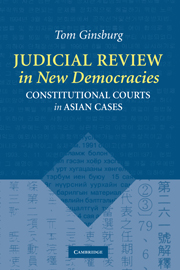Book contents
- Frontmatter
- Contents
- Acknowledgments
- Notes on Usage
- Judicial Review in New Democracies
- Introduction: The Decline and Fall of Parliamentary Sovereignty
- 1 Why Judicial Review?
- 2 Constituting Judicial Power
- 3 Building Judicial Power
- 4 Courts in New Democracies
- 5 Confucian Constitutionalism? The Grand Justices of the Republic of China
- 6 Distorting Democracy? The Constitutional Court of Mongolia
- 7 Rule by Law or Rule of Law? The Constitutional Court of Korea
- 8 Conclusion: Comparing Constitutional Courts
- Bibliography
- Index
8 - Conclusion: Comparing Constitutional Courts
Published online by Cambridge University Press: 21 July 2009
- Frontmatter
- Contents
- Acknowledgments
- Notes on Usage
- Judicial Review in New Democracies
- Introduction: The Decline and Fall of Parliamentary Sovereignty
- 1 Why Judicial Review?
- 2 Constituting Judicial Power
- 3 Building Judicial Power
- 4 Courts in New Democracies
- 5 Confucian Constitutionalism? The Grand Justices of the Republic of China
- 6 Distorting Democracy? The Constitutional Court of Mongolia
- 7 Rule by Law or Rule of Law? The Constitutional Court of Korea
- 8 Conclusion: Comparing Constitutional Courts
- Bibliography
- Index
Summary
An old proverb says that when elephants fight, the grass gets trampled. So it is with political conflict and democracy. When political conflict becomes too severe, democracy can be trampled by political institutions run amok. By transforming political conflicts into constitutional dialogues, courts can reduce the threat to democracy and allow it to grow. To play this important role of contributing to democratic stability and deliberation, courts must develop their own power over time.
Constitutional courts play games of power in legal arenas. Courts are empowered by constitutional designers and given tools to protect the constitutional bargain. But the subsequent choices courts make as they play their games can supplement or deplete their arsenals. Courts can challenge others or can seek powerful allies. They can cautiously accumulate policy gains in an incremental fashion or boldly battle for large pieces of territory. They can choose their battles carefully, limiting conflicts to those they can win and thus making future threats credible; or they can blunder badly and provoke crippling counterattacks.
This chapter draws some comparative conclusions from the three case studies of courts in new democracies. These cases, though unusual in the sense that they have been heretofore understudied, illustrate the universal political logic of judicial review and present a range of outcomes that can serve as the basis for broader theory.
THE DESIGN OF SYSTEM: JUDICIAL REVIEW AS INSURANCE
Chapter 1 analogized the decision to adopt judicial review to the decision to purchase insurance in uncertain contracting environments.
- Type
- Chapter
- Information
- Judicial Review in New DemocraciesConstitutional Courts in Asian Cases, pp. 247 - 264Publisher: Cambridge University PressPrint publication year: 2003



